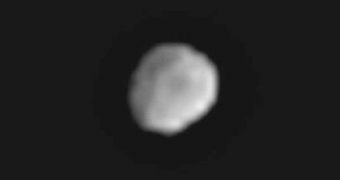As the NASA Dawn spacecraft is heading for a July 2011 rendezvous with Vesta, the largest asteroid in the solar system, the cameras on the probe have put together a short clip of the approaching space rock.
The new data will help mission controllers at the NASA Jet Propulsion Laboratory (JPL), in Pasadena, California, to better refine to trajectory of the spacecraft, ensuring that it will enter orbit around the asteroid flawlessly.
Data used for the creation of the movie were collected on June 1. Experts say that about 20 photos were taken of the asteroid, and then made to loop in the short clip. The datasets will be used for navigation purposes, NASA officials explain.
Interestingly, the images Dawn obtained show a dark feature on the asteroid's surface, which appears to be moving from left to right from the spacecraft's point of view. A huge dent – most likely a massive crater known to exist at Vesta's south pole – is also visible in the imates.
“Like strangers in a strange land, we're looking for familiar landmarks,” explains Dawn participating scientist Jian-Yang Li, who holds an appointment at the University of Maryland in College Park.
“The shadowy spot is one of those – it appears to match a feature, known as 'Feature B,' from images of Vesta taken by NASA's Hubble Space Telescope,” he adds. At this time, the Dawn camera resolution is the same as the finest Hubble images astronomers have of Vesta.
At this point, Dawn is scheduled to enter orbit around the asteroid on July 16. The reason why experts are so interested in it is because the object may be a protoplanet, a planetary embryo that never had a chance to develop properly due to outside influences.
“Vesta is coming more and more into focus. Dawn's framing camera is working exactly as anticipated,” says Max Planck Institute for Solar System Research lead framing camera investigator Andreas Nathues.
After it will spend around a year orbiting Vesta, the spacecraft will continue its journey through the Inner Asteroid Belt, until it reaches the dwarf planet Ceres. Once it achieves orbital insertion around this object, it will study it as well, for more than a year.

 14 DAY TRIAL //
14 DAY TRIAL //